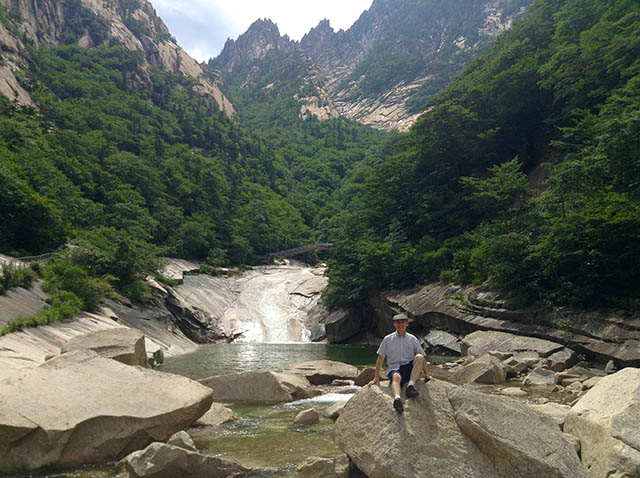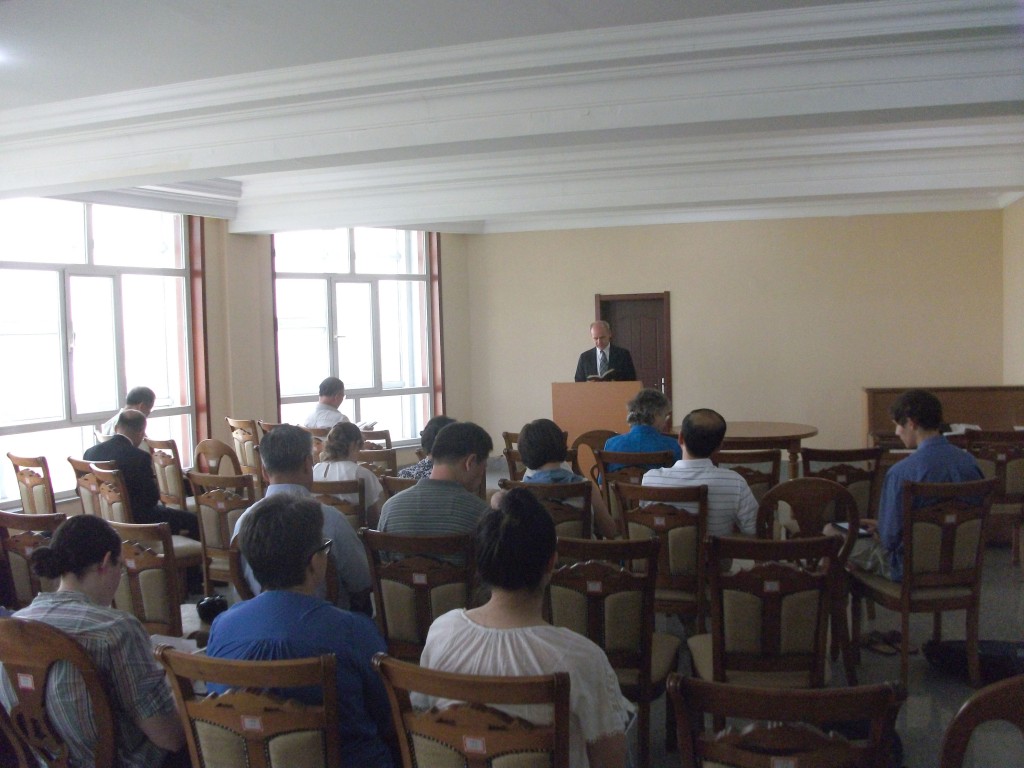The question: Is creation a viable model of origins in today’s modern scientific era?
I along with several million other people watched with great interest the debate on this question between Ken Ham and Bill Nye on February 4, 2014. As a former debater I was disappointed in the format, which allowed only five-minute rebuttals to thirty-minute speeches. In the interest of more complete rebuttal I offer here my personal reactions and responses to the case made by Bill Nye against a creation model of origins.
First I offer an important disclaimer. I am an engineer, not a credentialed scientist. However, I am encouraged to write by the fact that Bill Nye is in the same situation. He too is an engineer, and in a sense unqualified to speak about fossils, cosmology, evolution, radiometric dating, and a host of other scientific topics discussed during the debate. We must recognize that no single person in the whole world is simultaneously an expert in all of those subject areas. No one is fully qualified to engage in this debate, but engineers are applied scientists with a broad background of scientific knowledge. While scientists can sometimes become isolated in their ivory towers or stuck in their science labs, engineers are required to make things work effectively in the real world. This is not to minimize scientists, whose discoveries are the basis for all engineering advances. Nevertheless engineers have often been the ones to pursue the topic of origins broadly and to take the debate to the public in layman’s terminology.
1. Historical science
Bill Nye’s opening point was a denial of a distinction between observational and historical science. He said, “These are constructs unique to Ken Ham.” This became a theme of his throughout the debate, but it is demonstrably false. Ham in response quoted an Earth Science textbook, “In contrast to physical geology, the aim of historical geology is to understand Earth’s long history” (Earth Science by Tarbuck and Lutgens, Prentice Hall, 2006). My own quick search on Google revealed 212 thousand results for the phrase “historical science.” These range from the Wikipedia article on paleontology to the book Basic Questions in Paleontology by Otto H. Schindewolf (U. of Chicago Press), which says, “Paleontology is, then, a historical science.” Historical science can talk about possibilities and probabilities. Sometimes those probabilities are high enough to send people to jail and those impossibilities to set people free. However, historical science cannot ever repeat the experiment and observe the results.
By way of application, creationists hotly dispute whether evolution is even possible. However, establishing that something is possible does not prove that it happened. There is a world of difference between “He could have committed the crime,” and “He did commit the crime.” Even if evolution is possible, which I doubt, that doesn’t prove it is the actual history of life.
2. The Kentucky fossil
Bill Nye’s second opening argument involved sedimentary rocks and fossils. He brought to the debate a piece of local Kentucky limestone containing a fossil. By this he implies that creationists are ignoring the evidence that is sometimes right before their eyes. For creationists at large and me in particular this is false. I am deeply interested in fossils and see them as very important in the creation/evolution debate. I have in fact collected fossils in my state, including some nice shark’s teeth and an extinct Ecphora (sea snail) from South Carolina limestone. More importantly I have pondered the overall fossil record and noted with interest that the general pattern is one of sudden appearance, minimal change, and then sudden disappearance.
Stephen Jay Gould, the legendary evolutionist, wrote in his book Panda’s Thumb that
The history of most fossil species includes two features particularly inconsistent with gradualism:
- Stasis. Most species exhibit no directional change during their tenure on earth. They appear in the fossil record looking pretty much the same as when they disappear; morphological change is usually limited and directionless.
- Sudden appearance. In any local area, a species does not arise gradually by the steady transformation of its ancestors; it appears all at once and “fully formed.”
Certainly there are details of the fossil record that are a puzzle from a creation model, but taken as a whole it is remarkably consistent with creation and a flood.
3. Fossil crossover
In one of the most misunderstood moments of the debate, Bill Nye discussed Grand Canyon fossils. He said, “There is not a single place in the Grand Canyon where the fossils of one type of animal cross over into the fossils of another.” Several people immediately tweeted about polystrate fossils. Such fossils are interesting and important, and the Internet contains discussions of multiple examples. They are common and are clearly buried by rapid catastrophic sedimentation, passing through multiple layers of sediment. As such they are a potent argument in favor of a catastrophic flood. However, such fossils were not what Bill Nye had in mind. He said “cross over into the fossils of another,” not “cross over into other strata.”
Bill Nye refers to the fact that (oversimplifying a bit) trilobite fossils are often found deep and mammal fossils near the surface, and they are never mixed. This is a broad pattern around the world. In the particular case of the Grand Canyon, Bill Nye mentions trilobites at the bottom and sloth fossils (in caves actually, not in the sediment of the canyon walls) at the top.
A single undeniable counterexample would be powerful evidence. Bill Nye said emphatically, “If you could find evidence of that, my friends, you could change the world.”
The word undeniable above is part of the problem, because any such out-of-place fossils are instinctively rejected by mainstream scientists. Who knows how many fossils might have been discovered but never reported simply because they were so out of place that they could not possibly be legitimate from an evolutionary model? Given the strength of these world views, and the current rarity of counterexamples, I double there is any single fossil that would change Bill Nye’s mind.
Creationists do have a small set of counterexamples. They are rare, making this question a subject of much debate among creationists. There is a pattern to the fossil record that is perhaps explained by ecological zonation (sea animals buried together, of course), mobility (more mobile animals escape the early flood waters), etc.
In the case of Grand Canyon fossils, the majority are marine fossils. The trilobites that Bill Nye mentioned are in fact complex organisms with highly complex eyes, an evolutionary mystery to be so early in the record. Perhaps most importantly, there is no evolution in the Grand Canyon fossil record. For example, there is no trace of an organism the trilobite might have evolved from, or into. The details are sometimes confusing, but the big picture does not support evolution.
4. Natural laws
Bill Nye repeatedly pressed the false dichotomy between natural laws and theism. “Natural laws that applied in the past apply now,” he said, implying that creationism is a rejection of natural law. Creationists certainly accept natural laws, although we would perhaps call them divine laws. The God of the Bible is not like the fickle meddlers of pagan mythology who cause a constant stream of unpredictable events. He promises rather that “while the earth remaineth, seedtime and harvest, and cold and heat, and summer and winter, and day and night shall not cease” (Genesis 8:22). However, the God of the Bible also occasionally interrupts the natural order of things with a dramatic supernatural miracle. It is precisely because of the regularity of nature that we recognize these events as unusual miracles. These miracles are rare and purposeful. Being exceptions, they prove the general rule of natural law.
5. Danger of losing our technological edge
Based on a faulty understanding of creation and natural law, Bill Nye repeatedly presses the viewpoint that belief in creation will stifle discovery and innovation. Ham in response presents several counter-examples. In fact the history of technology is full of examples of theists, including many creationists, making contributions to science and engineering. I would like to think that I serve as a modest counterexample. Although I am a teacher rather than a practicing engineer, I have managed to get my name on a couple of patents and implement some modestly useful technological inventions.
The reason behind Bill Nye’s argument is the suspected rejection of natural law by creationists. Given that creationists like me accept and use natural law in our engineering work, this argument is simply incorrect.
6. Billions of believers
Bill Nye asserts that billions of believers do not accept young-earth creationism. By saying so he intends to marginalize creationism as an eccentric minority view. The word billions has shock value, but the statement is suspect. In the first place, no religion except Bible Christianity leads to the earth history held by Ham. The number of people worldwide who claim to follow the Bible is hard to determine but probably not more than a billion. Of those billion, only a minority accept the verbal inspiration and inerrancy of the Bible. Among that subset, belief in creation is fairly high. A June 2012 Gallup poll reported that “forty-six percent of Americans believe in the creationist view that God created humans in their present form at one time within the last 10,000 years.” The atheistic answer received only fifteen percent. Results vary widely depending on how the question is framed, but a consistently high percentage accept some form of creation.
I would assert the matching fact that billions of people doubt the naturalistic evolution story and suspect that a divine being is somehow involved, making atheism the eccentric minority view.
All of the above was contained in Bill Nye’s five-minute opening speech. I now turn to his thirty-minute main speech.
7. Zooxanthellae
Bill Nye began by returning to the Kentucky limestone. In particular, he mentioned the presence of fossil corals, which he confusingly called Zooxanthellae. Zooxanthellae are in fact the algae that live with corals in a symbiotic relationship. (As an aside, the evolution of symbiosis is a mystery from an evolutionary point of view.) I don’t believe that we find fossil Zooxanthellae; I think Bill Nye is referring to the corals themselves.
Nevertheless he offers these coral fossils as evidence that “we are standing on millions of layers of ancient life.” Millions of layers is surely an exaggeration. The exact number of layers in any location in Kentucky is difficult to determine, but my reading suggests the limestone is only a few hundred feet thick.
The second point is that sediments can be deposited very rapidly during catastrophic events like floods. A large accumulation of sediment is not necessarily an indication of long time. The corals, though, are an issue. Bill Nye mentioned that they lived “normal lives,” implying that the layers must have been laid down slowly. This is a complex topic, but these fossil corals have been widely discussed in the creation literature. A common suggestion is that they are pre-flood coral reefs buried in the flood, possibly transported and deposited on top of each other.
8. Ice cores
Bill Nye cited the counting of 680,000 snow-ice layers in ice cores in Greenland, the Arctic, and Antarctica as evidence of 680,000 years of snow accumulation. To begin with, I don’t know of any ice cores taken in the Arctic. Unlike the glaciers on the continent of Antarctica, there is only sea ice at the North Pole.
In fact nowhere have so many layers actually been counted. The famous Greenland core known as NGRIP has claimed only 110,000 layers, and that involves questionable multiple measurement techniques.
The Vostok core from Antarctica claims 420,000 years, but this is not based on an actual count of layers. Instead it is based primarily on a count of four supposed “glacial cycles” which are assumed to be 100,000 years each.
The EPICA core supposedly extends the record back to 700,000 years. These are not individually counted layers either. The age is “derived from the depth scale by a model” and the “earliest 100,000 years … are in the bottom 100 meters,” meaning the supposed ice layers are only 1 mm thick.
The suggestion that anyone has actually counted 680,000 layers is factually incorrect. Most importantly, the assumption of only one layer per year in all of these cores is highly questionable. Flood models predict an ice age right after the flood with dramatically higher snowfall and glacier growth. The layers might in fact be per storm, not per year. 4,500 years is enough to accumulate these glaciers with reasonable snowfall limits.
9. Old Tjikko
Next Bill Nye claims that “if we go to California, we find enormous stands of Bristlecone pines. Some of them are over 6,000 years old… 6,800 years old. There is a famous tree in Sweden, Old Tjikko… 9,550 years old.”
Again Bill Nye exaggerates the evidence. Old Tjikko is not that old. Wikipedia writes that “the trunk itself is estimated to be only a few hundred years old.” The 9,550 age comes from Carbon-14 dating of the roots, which are supposed to have survived the death and regrowth of the trunk. Flood models cast doubt on Carbon-14 dates like this, which depend on assumptions about the carbon content of the atmosphere.
The Bristlecone pines are better evidence, with dates based on actual tree-ring counts. However, it turns out that no single tree is that old. The National Park Service website states that “the oldest known living tree [is] about 4,600 years old.” The older dates come from correlations with fallen trees.
Creationists have been researching and writing about them for years, and a wealth of information is available.
Bill Nye repeatedly pressed Ken Ham for some predictions from a creation/flood model. Well, here is one. The flood model predicts that the oldest living things on the planet would date back to around the time of the flood. How does that work out?
Bill Nye asks, “How can these trees be that old if the earth is only 4,000 years old.” Note the double mistake which Bill Nye makes repeatedly in the debate. First, this is the supposed flood date, not the age of the earth. Ken Ham claims the earth is more than 6,000 years old. Some young earth creationists put it a few hundred or even thousand years earlier. Second, 4,000 years is a convenient rounding down. The youngest estimates put the flood at least 4,350 years ago. The difference is small but a few hundred years make a big difference with regard to the dating of these trees.
10. The Grand Canyon
Bill Nye then asks how the Grand Canyon sediments could have “settled out” in only one year. Under modern conditions, maybe not. Under catastrophic conditions, no problem. Modern limestones may slowly settle out, but the Grand Canyon limestones were more likely washed into place by erosion and deposition.
Speaking of modern observations, he says, “We can see that it takes a long, long time for sediments to turn to stone.” Bill Nye has abruptly switched from deposition of the sediment to lithification, a subject I am not very familiar with. There is however evidence that lithification can take place quickly under the right conditions.
Bill Nye then adds, “You can see where one type of sediment has intruded on another type.” It is hard to know what Bill Nye meant by this comment. Igneous rocks intrude into other types of rock; sedimentary rocks do not. If sediment fills a crack in another rock it is normally called a dike, not an intrusion. However, there are no igneous rocks or sedimentary dikes I can see in the accompanying photo.
Bill Nye adds that the Grand Canyon cuts through an ancient river bed. This raises the question of the origin of the canyon itself, not the sediments. The origin of the canyon is mysterious and controversial even among secular geologists. See the extensive creationist literature on the subject for full details. I believe the canyon is best explained by a catastrophic dam breech after the flood.
Bill Nye then asks, “If this great flood drained through the Grand Canyon, wouldn’t there have been a Grand Canyon on every continent?” Not all creationists see the canyon as carved by retreating flood waters. Erosion after the flood, perhaps from draining a large trapped lake, may be responsible. But why suppose it had to happen on every continent? Surely the topography of every continent was different.
And yet there are other large canyons, one recently discovered under the ice in Greenland that is larger than the Grand Canyon. The Copper Canyon group in Mexico is larger. The Yarlung Zangbo Canyon in China, the Kali Gandaki Gorge in Nepal, and the Cotahuasi Canyon in Peru are all huge as well. Furthermore, several huge submarine canyons exist under the oceans. If Bill Nye thinks giant canyons are a prediction of a flood model, then he has a problem, not us. The world has lots of giant canyons.
11. Those beautiful fossils
Bill Nye then returned to the “beautiful fossils” of the Grand Canyon, an issue discussed previously. Here he repeats the assertion that you “never find a lower one trying to swim its way to a higher one.” I think he again meant that they are never deposited in the higher layers. However, this assertion called to mind a well-known paper by creationist Kurt Wise in 2009. He describes finding trilobite tracks in one layer and trilobites themselves in a higher layer, as if the trilobites were climbing through successive layers of mud being deposited on top of them.
Bill Nye repeated his claim that “if you can find one example… the scientists of the world challenge you, they would embrace you, you would be a hero, you would change the world.” My experience with observing reactions to such finds suggests that Bill Nye does not accurately reflect the situation. Such finds are of course viewed with deep suspicion or reinterpreted as not out of place after all.
Here is one interesting example worth looking up if you are not familiar with it. Anomalocaris is a strange animal that is almost impossible to describe with words. It “belongs in” the Cambrian and was found in the famous Burgess Shale. It was assumed to have disappeared in the Cambrian until specimens were found in Ordovician rock in Morocco. Does this meet Bill Nye’s test of a fossil “swimming up to a higher layer?” No, this is merely a “surprising persistence” as are all fossils that show up too high in the record.
Complicating this issue is the presence of numerous false claims of out-of-place fossils by well-meaning but misinformed creationists.
12. Fossil Skulls
Bill Nye then shows a screen full of what are apparently hominid skulls. The point he is trying to make is not clear to me. He says “not any of them is a gorilla.” He asks, “Where would you put modern humans among these skulls?” This is an area I know little about, and his presentation leaves me more confused. I think chimpanzees are our supposed closest relatives, not gorillas.
Regardless, such a broad claim with no supporting details leaves little to respond to. My impression of the overall hominid fossil collection is that most of them are well within the natural variability of modern humans, especially when diseased humans are included. A creation model predicts an even larger variation in the past, for example the human giantism repeatedly mentioned in the Bible.
13. Kangaroo fossils
Bill Nye says that if kangaroos migrated from Mt. Ararat, where the ark landed, to Australia, we should find a trail of fossils in between. This is an astonishing assertion given that the starting population was only two (kangaroos on the ark) and the migration was rapid (well less than 4,000 years). The probability of leaving a fossil kangaroo along the way and of that fossil being found is vanishingly small.
Apply this logic to the claims of evolution. Bats supposedly evolved from some small ground-dwelling rodent-like mammal. This is a remarkable change that surely took millions of years to accomplish through the supposed slow process of evolution. Yet although we have many fossils of small mammals and many fossils of bats, there is no fossil of any significant intermediate. It is a dramatic gap in the fossil record that contradicts evolution. Bill Nye is wondering about kangaroo fossils, but he ought to be curious about bats. Kangaroos should be expected to leave some fossils in a 4,000 year migration, but shrews evolving into bats over millions of years do not?
14. The Land Bridge
More seriously, Bill Nye asks about the land bridge required for the kangaroos to migrate to Australia. A brief survey of the mainstream literature suggests a wide variety of opinions about if and when a land bridge existed. Land bridges around the world are believed to have existed during the ice age, which creationists place right after the flood. Obviously in a flood model sea levels are likely to be different from those in the mainstream model, so I don’t see any compelling reason there couldn’t be a land bridge. Lack of a land bridge now is certainly not compelling. Bill Nye says incredulously, “That land bridge has disappeared in the last 4,000 years.” Well indeed, as the glaciation of the ice age has disappeared. All the proposed land bridges in mainstream history have similarly disappeared. There is a shallow region known as the Torres Strait that would be the location of the land bridge.
Note also that a creation model doesn’t require a purely natural migration. Although modern creationists seem reluctant to invoke miracles out of fear of Bill Nye style accusations of scientific incompetence, the gathering and dispersion of the animals are two parts of the flood story likely to involve supernatural intervention.
15. Proliferation of species
Bill Nye compares the 16 million species (by his estimate) alive on the earth to a presumed 7,000 kinds on the ark and concludes that the creation model requires 11 new species a day.
Bill Nye is bothered by this rate. He says, “So you’d go out into your yard… you would find… every day a new species of fish, a new species of organism you can’t see.” This is silly; I am not likely to find fish in my yard and I certainly won’t observe organisms I can’t see. This points to an obvious part of the answer. New species may indeed have been appearing at a rapid rate over the last 4,000 years and much of it would be unobserved by humans.
I also question that 16 million estimate. That is a prediction, compared to only about a million actually identified so far. It is unreasonable to demand that creationists account for unobserved estimated species. A million species requires less than one new species a day. Not all of those needed to be on the ark, either. About a third are plants. The 30,000 species of fish could be from before the flood, along with the 81,000 mollusk species.
Note that creationists do not equate kinds with species. The scientific family Caninae is divided into over 30 recognized dog species. Biblically they would be called a single “kind.” Mainstream science agrees and accepts, according to the journal Science, “a common origin from a single gene pool for all dog populations.”
We have no problem with new species of animals developing as animals adapt to their post-flood world. This is not evolution, because all of the various traits being seen in those different species were present in the original pair in the ark.
I don’t see the problem here. 4,500 years seems like plenty of time to account for the current diversity, especially given the possibility of rapid adaptation after the flood.
16. The Lake Missoula flood
Creationists like the Lake Missoula flood because it is a dramatic illustration of the power of a large flood. Bill Nye questions how the large boulders transported by this flood could have ended up on the surface during Noah’s flood. However, it is obviously not Noah’s flood. It was caused by a failed glacial ice dam and fits nicely during a post-flood ice age. So there is nothing to explain here – Bill Nye simply doesn’t know the creation model of the Lake Missoula flood. The one point of contention is the possibility of repeated floods in the same location.
17. The Wyoming
Bill Nye questions the feasibility of the ark by describing the wooden six-masted sailing ship called the Wyoming. It was 330 feet long, somewhat smaller than the ark. He calls it the biggest wooden ship built. This strikes me as a confirmation that large wooden boats of that size are indeed possible, confirming the Bible’s story of the flood. In fact, some larger ships have been built that included a mixture of wood and metal. Some historical wooden ships, such as the Greek tessarakonteres and the Chinese treasure ships, may have been the size of the ark or larger. Of course boats much larger than the ark have been built out of metal.
Alas, says Bill Nye, the Wyoming was leaky and not seaworthy, proving that the ark probably would have been as well. Noah presumably had less skill than the Wyoming’s builders, so surely the ark was beyond his capability.
This is of course pure speculation. The ark wasn’t a sailing ship. We know nothing about Noah’s skill as a builder and what kind of help he might have had. Why must we assume he was unskilled and did it alone? Genesis 4:22 makes it clear that metalworking was known long before Noah. Noah likely has metal tools and perhaps reinforces parts of the ark with metal as well. Evolutionary thinking suggests that people living in ancient times must have been unskilled, but the Bible suggests otherwise, a point Ken Ham makes in rebuttal.
Additionally, the design of the ark was given to Noah by God. Add in the possibility of divine help and Bill Nye’s argument, like the Wyoming, doesn’t hold water.
Along the way Bill Nye suggests some additional problems, such as the feeding of the animals. He mentions that “Mr. Ham has some explanations for that,” which I will not rehearse here. We indeed have extensive creationist research into the feasibility of the ark account in the Bible.
18. Tiktallik
Bill Nye said, “What we want in science is an ability to predict.” He has in mind an outstanding example of a prediction based on evolution. He mentions the fossil record and admits the presence of gaps. He then cites as a prediction of evolution that those gaps will be filled in by transitional fossils. One of those gaps, he says, is between lung fish and amphibians. He then cites the Tiktallik, a 9-foot-long “fish lizard” as he calls it, as an example of just such a transitional fossil.
This fossil is thoroughly analyzed in several articles at the Answers in Genesis website. The paleontological details are complicated, but in summary Tiktallik is just a fish, albeit an unusual one. It is far from a dramatic missing link and still leaves a giant gap in the record. Perhaps most importantly, there is no sign of actual change at the Tiktallik site. Only by connecting it with unrelated fossils in other parts of the world can any kind of sequence be found. This is a dominant theme of the fossil record: astonishing variety but no evidence of change. A creation model has no problem with a fossil record full of variety.
19. The Red Queen
Deep into his talk, and facing audience fatigue, Bill Nye nevertheless launched into perhaps his most complex argument. Tweets suggested the audience didn’t follow this argument at all, so some background information is needed. Here is the core idea: Primitive life reproduces asexually (bacteria simply divide, for example). How sexual reproduction would ever evolve is one of the mysteries of evolution. Bill Nye here is responding to a creationist criticism of evolution, not attacking creation. If evolution is true, there must be some survival advantage to sexual reproduction. Evolutionists have two theories to explain this. One theory is that sexual reproduction is better at purging bad mutations. The second theory is that sexual reproduction enables organisms to fight disease better.
This second theory is known as the Red Queen Hypothesis, after the Red Queen in Alice in Wonderland. Bill Nye didn’t use this phrase or explain his image, but on the screen was a drawing of the Red Queen and Alice.
Scientists found a test of the Red Queen Hypothesis in the topminnow, which is able to reproduce both sexually and asexually. Research found that sexually reproducing topminnows had fewer parasites.
Creationists react to all of this with a shrug. Sexual reproduction is no problem from a creationist point of view. It’s the evolutionists who have a lot of explaining to do here. And disease resistance may provide an advantage to sexual reproduction, but it doesn’t begin to explain all that is required for an organism to evolve the mechanism of sexual reproduction in the first place.
Bill Nye’s point seems to be that this is a successful prediction of evolutionary theory. We predicted that the sexually reproducing fish would be healthier, and indeed they are, he asserts. I am not enough of a biologist to say what a creation model of topminnow health might predict, but I see this whole issue as having little impact on the question at hand.
He asks rhetorically, “How else would you explain it?” I don’t understand his question. If he means, “How else would you explain the evolution of sex,” that is his problem to explain, not mine. If he means, “How else would you explain that sexually reproducing minnows are healthier,” I would say that is simple observational biology. It has nothing to do with the question of origins.
20. The Big Bang
Bill Nye mentioned a church sign about the big bang and expressed his incredulity that anyone could question the big bang. He offered two classic pieces of evidence for the big bang.
First, he said that the universe is expanding. This is an observational fact, one that creationists readily accept. It is the extrapolation back into the past that we disagree with. In a creation model, the universe has been expanding ever since creation. The current expansion can’t be used to test which model is true – it fits in both models.
Second, he describes the cosmic microwave background (CMB) radiation in space. This is a complex topic covered at length in the creationist literature. My impression is that the background radiation fits as well in creationist models as it does in big bang models. It is important to secular scientists because it supports a big bang over other competing naturalistic theories, not because it disproves creation or a young universe.
21. Radiometric Dating
Bill Nye raised the most significant old-earth proof, that of radiometric dating of rocks. This familiar argument has been debated for decades. The classic creationist response is to question the assumptions (initial conditions, constant decay, closed systems) and to point to examples of unreliable results. Ken Ham’s rebuttal description of wood in basalt is one such example.
Bill Nye’s particular example, rubidium-strontium, is a complicated one. It supposedly solves the problem of unknown initial conditions through a process known as isochron dating. Bill Nye hints at this with his description of how the elements are “locked in place” when the rock solidifies.
In recent decades some creationists have felt that the answers above, while true, are not a complete answer. As a result, the Institute for Creation Research in 1997 launched an eight-year research effort known as R.A.T.E. (Radioactivity and the Age of The Earth). They published two technical books and a non-technical summary called Thousands … not Billions. The primary contributions are some new young-earth evidences and some evidence of higher decay rates in the past.
Interested readers are encouraged to consult the extensive creationist literature on this topic for more information.
Bill Nye mentions fossils in the Ashfall Fossil Beds in Nebraska. This is an important example for two reasons. First, it illustrates that we date igneous (volcanic) rocks, not sedimentary rocks. These fossils are candidates to date using a rubidium-strontium method because they are buried in volcanic ash rather than sediment. Second, Bill Nye may be hinting that volcanoes, not the flood, are responsible for some fossilization. The Creation Research Society Quarterly Fall 2009 contains a lengthy technical article with a creationist interpretation of the Ashfall Fossil Beds.
22. Education in Kentucky
Bill Nye explains that another isotope of rubidium is used in nuclear medicine. In one of several slights to the state of Kentucky, Bill Nye states that there is no school in Kentucky at which you can obtain a degree in nuclear medical technology. An Internet search immediately tells me that Jefferson Community College in Louisville has a Nuclear Medicine and Molecular Imaging Program. Bluegrass Community and Technical College in Lexington has a Nuclear Medicine Technology program. Bill Nye appears to be misinformed on this point. I am dismayed at how few reporters writing about the debate performed this simple fact checking. Ironically, Bill Nye’s home state of Washington appears to have only one such program on the same list (nmtcb.org).
23. Distant Starlight
Bill Nye says that we measure the distance to stars by triangulation. This is true, but only for nearby stars. The Hipparcos satellite, designed to make these measurements with high accuracy, can estimate distances to only a few hundred light years. Thus Bill Nye’s graphic, implying that stars further than 6,000 light years away are measured this way, is factually incorrect. The way we measure distances to further stars is a complicated but very interesting story.
Despite this factual error, as a creationist I don’t deny those distance measurements. I think the stars are indeed vast distances away, the vastness of space glorifying God as explained in Psalm 19:1.
Explaining how we can see them is the issue. How did the light get here in only 6,000 years? This is another decades-old argument that has a classic simple answer and a more sophisticated modern answer. The classic simple answer is that God created light on the way, an example of “apparent age” in creation. Apparent age is an inherent part of a creation event, but many creationists think there is more to the story than simply apparent age. A recent Answers in Genesis paper lists seven different possible explanations and proposes an eighth (miraculous acceleration of the speed of light during day four of creation).
24. The Bible in English
Bill Nye repeatedly made the accusation that the Bible is not trustworthy because it is the result of a long sequence of faulty translations. Here Bill Nye shows a misunderstanding of the history of the Bible. I would invite him to find a Hebrew expert and go visit the Isaiah scroll in Jerusalem. Mainstream science dates it back halfway to the flood, if you will. A comparison with a modern English translation reveals that the Bibles we read in English are remarkably accurate. The “Dead Sea Scrolls” from which the Isaiah scroll came contain only fragments of Genesis, but abundant manuscripts from a few centuries later testify that Genesis is also well preserved and faithfully translated.
25. Rebuttals and questions and answers
At this point I have addressed only Bill Nye’s opening two speeches. Some other issues were raised in the rebuttals and question time, but those will have to wait for another time.



















